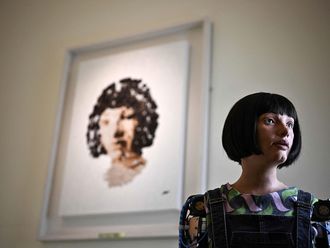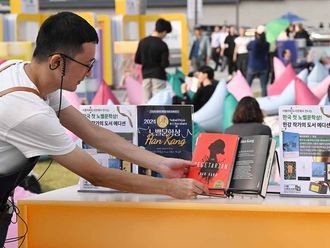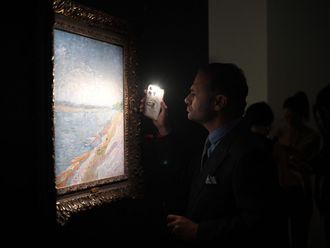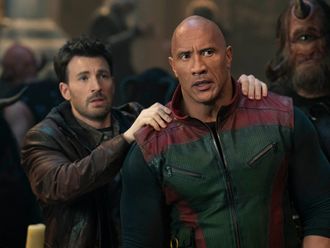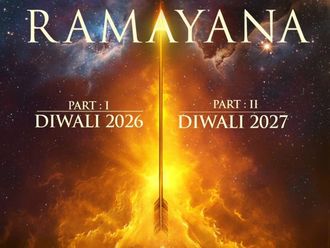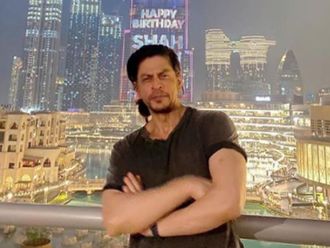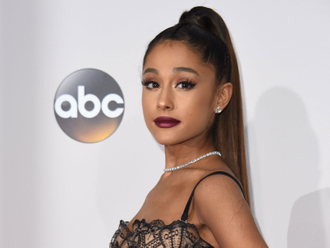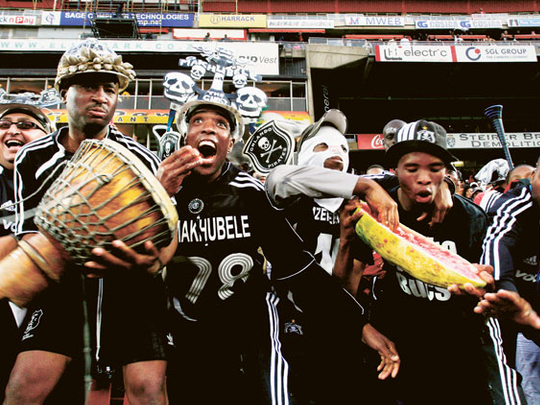
According to African artists, the continent has been presented as one of tears, agony, war and famine. But its artists say it also invokes feelings of joy and happiness. They tell Africa's story — in a four-part exhibition As It Is! — revealing their feelings and experiences, as seen through the lens of reality, credibility.
The exhibition focuses on the ignored parts of the dark continent without the biased intermediary of Westerners. All the artists in the exhibition are showcasing their works in Dubai for the first time.
Rushay Booysen, born and raised in Africa, is a photographer, music expert and culturist. "To me Africa Uploaded [the first part of As It Is!] was an Afrocentric view reflective of our communities. Images were one of the mediums used there." Booysen showcased three photos plus several others in the slide installation.
He explains the tales behind his photos. "I question what I see around me — be it a gun in the holster of a police officer or a raised black fist, which could have various interpretations. But I like the viewer to understand my concept behind it."
In terms of the philosophy he loaded his immortal slides with, he said: "One of my philosophies mirrored the importance of opening a fruitful debate. So if this exhibition can reach that aim, I will feel my mission has been accomplished."
His artistic yet humane message revolves around the idea of rebranding. "Africa needs to be rebranded and it's important that these voices come from within the continent. As the phrase goes: ‘Until the lions have their own historians, the history of the hunt will always glorify the hunter.' Once I realised that, I had to be that historian," he said.
Asked how he evaluates the present situation in Africa and to what extent it has had an impact on his art, he said: "The present situation is a creation of a particular past and to understand that one needs a deep analogy." But as an artist, what does he not like about what is going on in Africa? And what does he look forward to seeing in its place? "I feel Africa needs young, fresh leaders who aim at uniting Africans and boost trade among its states. I would love to see more African people travelling between states. There is so much we can learn from each other and there is no need for us to import sub-cultures that destroy the values of our diverse societies," he said.
Booysen will have a busy artistic schedule in March. "Indeed, I have a project in March on the identity of South Africa's mixed racial population, in which I'll be exhibiting alongside a Mexican friend at an indigenous festival in Australia," he said.
Ntare Guma Mbaho Mwine is an artist working in the mediums of photography, theatre, film and television. "Africa Uploaded featured my photographic perspective on Uganda and Mozambique."
Mwine showcased five artworks. "Each image showed a slice of life in Uganda and Mozambique ‘as it is', as the title of the exhibition series goes," he said.
The photographer spent several months working in various countries in Africa. "I feel proud to be part of such a crucial exhibition. I am just a small piece in the grand exhibit that has been put together, which presents a varied set of beliefs and theories on art from Africa," he said.
Regarding the message he conveyed through the exhibition, he said: "I always look for striking images when I set out to take a photo. But I do not have a particular message in mind. I am not a preacher but am playing one in a short film I am making at present. I had the good fortune to be able to shoot some footage for the film during my recent trip to Dubai," he said.
"Africa is hot right now," he said. "In more ways than one. This has forced me to keep shooting in new and innovative manners. Of late I have been shooting a lot of High Definition video, which I am really excited about. Artistically speaking, I love what is going on in Africa right now. The World Festival of Black Arts was a huge success in Dakar, Senegal, recently. I just got a message from a musician friend, Somi, who sang for President Wade, President Gaddafi and President Sirleaf-Johnson at Dakar's Presidential Palace on a live broadcast to the Francophone world. There are so many incredible art festivals happening in the continent right now. It's even more exciting to see that the work from the continent is now making its way to Dubai. I look forward to continue being part of this wave that is crossing traditional boundaries. The Dubai International Film Festival is honouring Malian filmmaker Souleymane Cissé with a Lifetime Achievement Award."
Antony Kaminju is a photographer from Nairobi, Kenya. He works between Nairobi and Johannesburg, where he also teaches photography at the Witwatersrand University. "I'm passionate about the African story as told by us. Africa has been projected as a continent of tears, agony, war, famine, etc … But we also have tears of joy. I want to tell that tale through my camera. What makes Africa unique is its diversity in people and beauty." He displayed seven prints of the football fans series, the "black diamond" and the "mime".
Kaminju has been inspired by different photographers of different genres. "Indeed, I am always keen to see what others are doing and how they interpret situations. I'm a people person and people inspire me."
He wants to inform others about the true Africa. "Africa has great stories that need to be told credibly. I find that the more I take photographs, the more I seem to question what's going on around."
"Africa is just like any other place in the world, with its ups and downs. But it is projected in a negative way — always. Think about this, we have lots of NGOs working in Africa to ‘save Africa'. But who are the ones employed in these NGOs? Can't they employ local people and pay them as professionals? We have big foreign-media presence in Africa. Can't they employ local people who can tell Africa's story? And why is it that every story coming from Africa is about war? If a story does not have mention of an AK47, HIV/Aids, militia, dictators, child soldiers, Mandela, etc, it is not considered a story worth going on TV or print. The Western world has systematically created its own picture of Africa, which it sustains through NGO machinery and its uninformed media!" Kaminju said.
About his upcoming projects, he said: "At the moment, I'm in Mombasa, a coastal town in Kenya dating from AD1,600. I want to work with the local youth to tell the stories from this end. It's agonising that there is not much information about the city — only a handful of catalogues and tour guide brochures designed to please tourists. This is my battle: How do we tell our own stories without the commercial aspect of tourists and explorers? I can't do it alone, so I need like-minded artists who will put in the effort to research, understand and document those elusive, bright moments the Western media ignores. It's our story and no one can tell it better than us," he said.
Angèle Etoundi Essamba was born in Douala and grew up in Yaoundé, Cameroon. "As a young girl, I went to Paris, where I received my education. Later I moved to the Netherlands, where I was trained at the Nederlandse Fotovakschool [the Netherlands' professional school of photography]. My photographs were first displayed in 1985 at the Maison Descartes in Amsterdam. Since then, other exhibitions have followed in Africa, Europe, South America and the United States," she said. "I focus on portraits of black women that question identity, alterity and cultural duality and promote respect, understanding and tolerance. It shows the consciousness of African women and the relation between tradition and modernity. So I present a vision of women, Africa and its culture. I find inspiration in my African heritage."
About the exhibition, she said: "The feedback on Africa Uploaded has been positive. It shows how important it is to organise more such shows on a larger scale. African artists deserve more visibility and, hopefully, other exhibitions will follow." Essamba showcased five images in the exhibition.
In terms of the situation in Africa, she said: "There is still a long way to go but we are on the move. Speaking in terms of art, apart from a few areas, there is a lack of appropriate avenues for artists to showcase their work and get publicity. Debates, meetings and exchanges must increase. We really need a stronger cultural engagement from our governments. The annual art meetings in countries such as Senegal and Mali have shown this is possible."
She is also working on a project on the Afrodescent population. "This includes African and diasporic women and will be presented in different countries in 2011, proclaimed the United Nations year of the Afrodescent population," she said.


